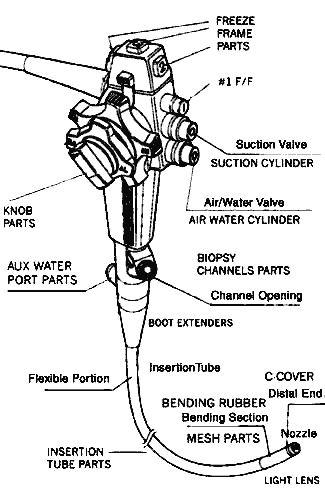Welcome to DU!
The truly grassroots left-of-center political community where regular people, not algorithms, drive the discussions and set the standards.
Join the community:
Create a free account
Support DU (and get rid of ads!):
Become a Star Member
Latest Breaking News
General Discussion
The DU Lounge
All Forums
Issue Forums
Culture Forums
Alliance Forums
Region Forums
Support Forums
Help & Search
General Discussion
Related: Editorials & Other Articles, Issue Forums, Alliance Forums, Region ForumsMaker of tainted medical scopes issues new cleaning guide.
So the company that has dominated the global market for endoscopes for over a half century, whose endoscopes have been used by for the majority of endoscopies for decades, now discovers, after an outbreak of antibiotic resistant bacteria at 2 California hospitals, that it didn't know enough about disinfecting endoscopes to devise an adequate disinfection protocol for its duodenoscope.
Maker of tainted medical scopes issues new cleaning guide
By MATTHEW PERRONE, AP Health Writer, March 26, 2015
WASHINGTON (AP) — The maker of medical scopes that have been linked to two recent "superbug" outbreaks at California hospitals has issued new cleaning instructions for the devices amid scrutiny from regulators, lawmakers and medical professionals. . . . Olympus America sent the new guidelines to U.S. hospitals on Thursday, recommending that its customers begin using them as soon as possible. The updated guidelines call for using a smaller cleaning brush and additional flushing steps to remove debris and disinfect the scope's crevices and hinges. Olympus plans to send the new brush to hospital customers by May 8.
The company's scopes were linked to infections of antibiotic-resistant bacteria in 11 patients at two separate Los Angeles hospitals last month, contributing to the deaths of two of those patients. Hospital staff said the infections occurred despite following Olympus' instructions for cleaning the devices, known as duodenoscopes. . . . The scopes consist of a flexible fiber-optic tube that is threaded down the throat, through the stomach and small intestine to diagnose and treat conditions in the pancreas and bile ducts. The tip of the scope includes moveable parts for instruments to help remove tumors, gallstones and other blockages. But this complex design also makes the instruments difficult to clean. Bodily fluids and other debris can stay in the device's joints and crevices even after cleaning and disinfection.
The FDA said in a statement it is reviewing the new cleaning instructions from Olympus as part of a broader evaluation of the company's device. . . . The agency previously disclosed that Olympus did not seek federal clearance for the latest version of its duodenoscope, which it began selling in 2010. FDA clearance is required for all substantive updates to medical devices sold in the U.S. The company's Olympus TJF-Q180V duodenoscope is currently under FDA review. . . . Seven lawsuits have been filed against Olympus in Los Angeles County Superior Court on behalf of patients, alleging negligence and fraud by the company.
http://www.chron.com/news/medical/article/Maker-of-tainted-medical-scopes-issues-new-6161040.php
If the Olympus duodenoscope has smaller biopsy channels than a colonoscope, it could be more difficult to adequately disinfect using only the chemical disinfectants that these heat intolerant fiberoptic scopes will tolerate, especially given the difficulty of adequately removing all material from the biopsy channels.
Unlike bacterial infections, which if it does not result in an acute infection, often resolves spontaneously, hepatitic C usualloy lies dormant for years or decades before symptoms develop. Of the estimated millions of Americans walking around with undiagnosed occult infections, many when eventually diagnosed turn out to have no known risk factors. The long latency period between infection and symptoms/diagnosis makes it virtually impossible to know how or when the infection was acquired.
Despite these difficulties, isolated cases of endoscopically transmitted hepatitis C have been documented after contaminated colonoscopies, generally following a coloscopy which required biopsy. When such a case is identified, other patients who had proceedured with the same scope can be notified for testing. Small outbreaks have been documented in this fashion.
But without such an index case who becomes acutely ill shortly after the proceedure, it is unlikely that isolated asymptomatic endoscopic transmissions will be diagnosed until it becomes symptomatic years later, when it will impossible to correlate the infection with theinfecting event.
Given the often non-specific symptoms, occult status, and long latency period of hepatitis C, and the many patients diagnosed each year who have had undiagnosed subclinical disease for years despite having no midentified risk factors for hepatitis C, a most relevant question becomes :
How many cases of hepatis C (bothnthose currently diagnosed and undiagnosed occult cases) have been caused by inadequate chemical sterilization of difficult-to-brush-out and impossible-to-heat-disinfect endoscopic biopsy channels?
The fact that the major pioneer in medical endocopy, after 50 years, still can't come up with an effective protocol when it markets a new scope is more a bit disconcerting.
(Here's a bit more
Patient Safety Authority, Commonwealth of Pennsylvania
The Dirt on Flexible Endoscope Reprocessing

Endoscope Infection Risk Highlighted in FDA Warning

InfoView thread info, including edit history
TrashPut this thread in your Trash Can (My DU » Trash Can)
BookmarkAdd this thread to your Bookmarks (My DU » Bookmarks)
0 replies, 2311 views
ShareGet links to this post and/or share on social media
AlertAlert this post for a rule violation
PowersThere are no powers you can use on this post
EditCannot edit other people's posts
ReplyReply to this post
EditCannot edit other people's posts
Rec (2)
ReplyReply to this post